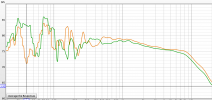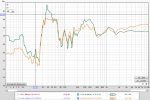Agree. My own sets are usually a blend of Manual and Auto corrections. The >500Hz region I always do by hand.It’s surprising how different the filters come out with different settings. For instance, I don’t know why only one set of filters (I did 6) addressed the 3k dip. I can’t identify something in the settings that drove that.
-
WANTED: Happy members who like to discuss audio and other topics related to our interest. Desire to learn and share knowledge of science required. There are many reviews of audio hardware and expert members to help answer your questions. Click here to have your audio equipment measured for free!
You are using an out of date browser. It may not display this or other websites correctly.
You should upgrade or use an alternative browser.
You should upgrade or use an alternative browser.
Embarking on REW/Roon DSP exercise
- Thread starter ahofer
- Start date
- Thread Starter
- #42
Yeah, switching back and forth, my subjective impression is of somewhat greater clarity. I should probably create two channel convolution. Another weekend…
So I was wondering why the convolution as Roon also has 'regular' PEQ functionality. But I understand this is the way to get a set of filters from REW into Roon in one go, correct?[...]
4)created filters and exported to WAV
5) imported as convolution filter
[...]
In that case I'd certainly find a way to remeasure with EQ on. Just to be sure that what you see is what you get.
Last edited:
Yes. This is what I would try first.I suppose if I can put some pink noise in my library and play it through ROON while doing RTA I might get there.
In the REW Generator, you can use the 'Save to file' option to get exactly the pink noise you'd play from REW during an MMM. Adjust the number of repetitions to get a track of a couple of minutes.
With this in hand you should be able to exactly replicate your MMM from within Roon.
- Thread Starter
- #45
I posted a description of all of this in the Harbeth User Group. I'll be interested to see whether Alan lets it through. I pointed out that the 1.2k bump and 3k dip are consistent with the Stereophile measurements of this speaker's predecessor (as well as consistent with his crossover and driver/cabinet design choices). I didn't mention the ~150H resonance.
- Thread Starter
- #48
Here's a calculation of room modes for my space. REW is certainly attempting a lot of work above the 155Hz Schroeder frequency. It's also difficult to see how this corresponds to my measurements. I can see the nulls from the spaced modes (marked in red) are consistent with the measurements. The peaks seem a little off.
This has all been pretty interesting. I have a lot to do in my next measuring session (my wife absolutely hates hearing sweeps and pink noise, so I'll wait until she's out again). I think I've found a way to use REW to approximate the Schroeder frequency, and I want to do stereo convolution because there are some balance anomalies I notice that vary with frequency.


This has all been pretty interesting. I have a lot to do in my next measuring session (my wife absolutely hates hearing sweeps and pink noise, so I'll wait until she's out again). I think I've found a way to use REW to approximate the Schroeder frequency, and I want to do stereo convolution because there are some balance anomalies I notice that vary with frequency.
Last edited:
Is this the crossover point? I see this sort of dip with every speaker in my room, and it tracks the crossover frequency.the 3k "dip" I had in the unaltered response (where the Harbeth are more directional)
You can also export the sweep and play that from roon whilst rew is waiting to measure.Yes. This is what I would try first.
In the REW Generator, you can use the 'Save to file' option to get exactly the pink noise you'd play from REW during an MMM. Adjust the number of repetitions to get a track of a couple of minutes.
View attachment 255767
With this in hand you should be able to exactly replicate your MMM from within Roon.
I do similar, using PEQ with (often very) low Q values as a much more precise tone control, tuned by ear to what sounds most correct to me over a wide selection of music.Agree. My own sets are usually a blend of Manual and Auto corrections. The >500Hz region I always do by hand.
- Thread Starter
- #52
First, thank you for your input on how to do this! I have an ADI DAC as well as Roon, so in NY I can mix and match PEQ above and below transition, which might be a good way to try out the effects.Is this the crossover point? I see this sort of dip with every speaker in my room, and it tracks the crossover frequency.
3.2Khz is indeed the crossover. I'm going to measure my Revels this weekend and I'll let you know, but I think some designs handle crossovers more effectively, both in nearfield and dispersion response. I'm also going to do a couple of nearfield sweeps at some point.
Note the measured results from Stereophile, showing a small nearfield bump between 1-2kHz and (both horizontal and vertical) dispersion sound power loss 2-3kHz before a peak at 5-6kHz. This measurements occasioned some dialogue about vertical mic positioning, but that only serves to point out other things:
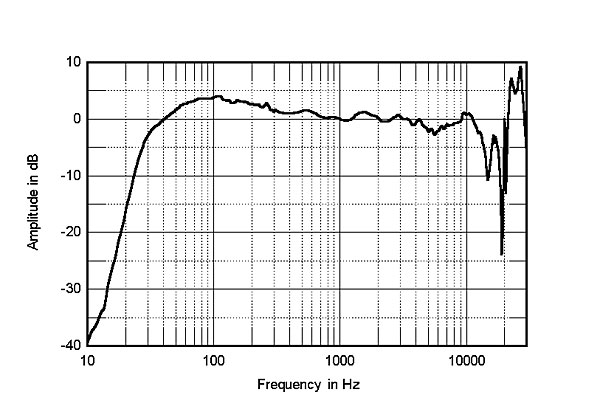
Lateral (see + sign):
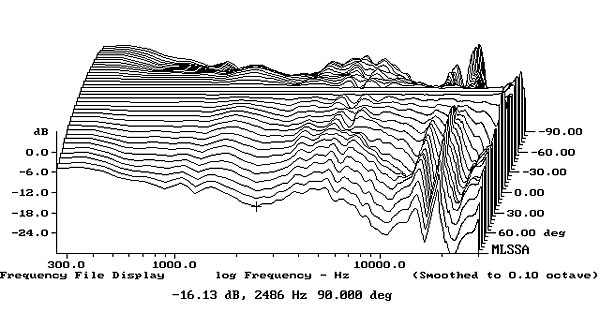
vertical (mic placement for nearfield!!)
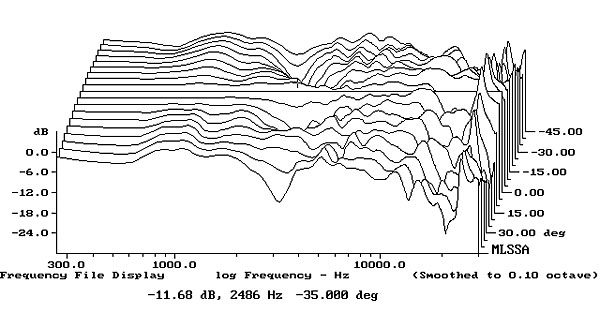
You can mix and match in roon as well, I do convolution for the low end fixes, and PEQ for the top end test fixes often in roon. If the RME is nicer to use for dialing in it makes sense to use that, but I'd prefer laptop and roon to the RME buttons and display, I did not gel with its control system.First, thank you for your input on how to do this! I have an ADI DAC as well as Roon, so in NY I can mix and match PEQ above and below transition, which might be a good way to try out the effects.
3.2Khz is indeed the crossover. I'm going to measure my Revels this weekend and I'll let you know, but I think some designs handle crossovers more effectively, both in nearfield and dispersion response. I'm also going to do a couple of nearfield sweeps at some point.
Note the measured results from Stereophile, showing a small nearfield bump between 1-2kHz and (both horizontal and vertical) dispersion sound power loss 2-3kHz before a peak at 5-6kHz. This measurements occasioned some dialogue about vertical mic positioning, but that only serves to point out other things:

Lateral (see + sign):

vertical (mic placement for nearfield!!)

Crossovers with steep slopes, and drivers in waveguides will behave better, coaxial should be perfect. In room measurements are only guides to what we hear over the transition frequency, you probably don't want to fix the dip, maybe slightly, when everything else is good.
AmazingI’m about to get going on a measurement-to-convolution file exercise, now that I have Roon adequately powered in my home. I would welcome any suggestions, and I will try to post my results ASAP.
I ran a few initial sweeps last night, and they look awful. I can’t yet figure out how to put together the filters, but I am googling about for answers. Starting here:
https://community.roonlabs.com/t/a-...w-and-rephase-using-convolution-filters/90990
My cat has taken the listening position, however:
View attachment 88156
- Thread Starter
- #56
Just did the Revels - two channels as promised.. I took near sweeps and moving mic, and listening position sweeps and MM. Interesting consistency except for some obvious room boundary effects (I’ve forgotten how you narrow down the time window to get rid of reflections..).
I’ll post the measurements forthwith, but I’ve had an interesting experience: I measured with the speakers in two positions. One (labeled “IN” in my measurements) is in the spot my wife would prefer I keep them - out of the way, not equidistant from my preferred position. So not great. But I created a convolution for that position and the improvement is incredible. There was a lot of boundary bass reinforcement in the left channel, and obviously some level correction was necessary. It sounds great now - nice house curve bump in the bass but a lot more clarity as I switch it in and out. I think my EQ’d “IN” position is better than non-EQ’d “OUT”.
The measurements still look pretty horrible, but we know this room has a lot of issues.
I’ll post the measurements forthwith, but I’ve had an interesting experience: I measured with the speakers in two positions. One (labeled “IN” in my measurements) is in the spot my wife would prefer I keep them - out of the way, not equidistant from my preferred position. So not great. But I created a convolution for that position and the improvement is incredible. There was a lot of boundary bass reinforcement in the left channel, and obviously some level correction was necessary. It sounds great now - nice house curve bump in the bass but a lot more clarity as I switch it in and out. I think my EQ’d “IN” position is better than non-EQ’d “OUT”.
The measurements still look pretty horrible, but we know this room has a lot of issues.
Last edited:
It’s described here.I’ve forgotten how you narrow down the time window to get rid of reflections..

How to make quasi-anechoic speaker measurements/spinoramas with REW and VituixCAD
Quasi-anechoic measurements are a way to capture the 'real' frequency response of a speaker without the influence of a room. They are called 'quasi-anechoic' because they have the potential to get you really close to the results one might achieve with a non-reflective environment like an...
 www.audiosciencereview.com
www.audiosciencereview.com
- Thread Starter
- #58
So, some observations and graphs:
1) I don't have the nearfield measurements down, need to work on it
2) Moving mic is a better basis for EQ. It's worth doing the sweeps and seeing the consistency (or lack). I think you'd need to average a lot of sweeps to get a good EQ basis, which ends up as....moving mic. No?
3) These are Revel 228Be speakers, so we are starting with a speaker that measures pretty well. Rooms are a bummer.
So: Here are the left channel listening position measurements. You can see the MM measurement smooths things out, and the lower frequencies are very similar. (dark green is the sweep, obv.)

Right channel, even more vivid, same comparison (blue is sweep,if you can't tell):

And the left (blue) and right with the speakers in the pushed back, asymmetrical, suboptimal, wife-preferred positon ("IN"), which produced such a satisfactory result post EQ - the boundary effect and peaks are very different. One thing that's a little surprising - the differences around 300 and 100 Hz.

Here's right (orange) and left with the speakers moved out to symmetry (but still with some stuff in the way and a weird orientation to the room). Still some significant differences above and below transition. Look at 40 Hz, 160 Hz, and the whole range from 250-1000Hz!!

Just for laughs, here are some nearfield measurements, although the speakers were oriented very differently in the room (if pulled out from walls). Still a few things that I think must be above Schroeder (200-300). I mean, middle C for heck's sake!

1) I don't have the nearfield measurements down, need to work on it
2) Moving mic is a better basis for EQ. It's worth doing the sweeps and seeing the consistency (or lack). I think you'd need to average a lot of sweeps to get a good EQ basis, which ends up as....moving mic. No?
3) These are Revel 228Be speakers, so we are starting with a speaker that measures pretty well. Rooms are a bummer.
So: Here are the left channel listening position measurements. You can see the MM measurement smooths things out, and the lower frequencies are very similar. (dark green is the sweep, obv.)
Right channel, even more vivid, same comparison (blue is sweep,if you can't tell):
And the left (blue) and right with the speakers in the pushed back, asymmetrical, suboptimal, wife-preferred positon ("IN"), which produced such a satisfactory result post EQ - the boundary effect and peaks are very different. One thing that's a little surprising - the differences around 300 and 100 Hz.
Here's right (orange) and left with the speakers moved out to symmetry (but still with some stuff in the way and a weird orientation to the room). Still some significant differences above and below transition. Look at 40 Hz, 160 Hz, and the whole range from 250-1000Hz!!
Just for laughs, here are some nearfield measurements, although the speakers were oriented very differently in the room (if pulled out from walls). Still a few things that I think must be above Schroeder (200-300). I mean, middle C for heck's sake!
Attachments
I find MMM better for EQ as well, and it's quicker to do, it feels like the right approach for below the transition frequency.
From a quick look your IN position looks like it might be better after EQ then the out. Access to full DSP changes the rules for speaker positioning, a huge wall bass boost is no longer a bad thing with DSP, can even be viewed as a good thing with displacement limited speakers.
From a quick look your IN position looks like it might be better after EQ then the out. Access to full DSP changes the rules for speaker positioning, a huge wall bass boost is no longer a bad thing with DSP, can even be viewed as a good thing with displacement limited speakers.
- Thread Starter
- #60
Just doing some post-EQ measurements now. Starting with my desktop system (Genelec 8010s with 7040A subwoofer). As you can see, peaks are malleable, nulls...well, I had limited EQ boost to 2 db, and it does seem to have pushed some of them up. Hmmm?
My ears (where I did the MM) are above the best axis for these speakers.
Right:

Left:

My ears (where I did the MM) are above the best axis for these speakers.
Right:
Left:
Attachments
Similar threads
- Replies
- 0
- Views
- 365
- Replies
- 6
- Views
- 2K
- Replies
- 52
- Views
- 4K
- Replies
- 86
- Views
- 7K
- Replies
- 72
- Views
- 5K

